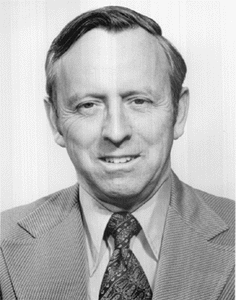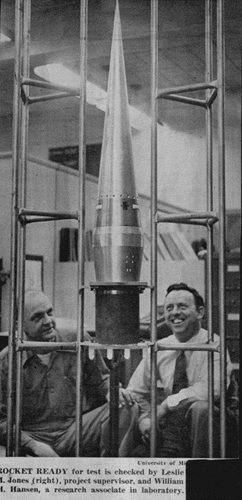
Leslie M. Jones

Adapted from an 11 December 1979 Memorial by Margaret Fillion,
Academic Secretary of the Aerospace Engineering Department,
University of Michigan


Adapted from an 11 December 1979 Memorial by Margaret Fillion,
Academic Secretary of the Aerospace Engineering Department,
University of Michigan
Prof. Leslie M. Jones, a member of the University of Michigan faculty for 32 years, died of leukemia on October 13, 1979, at the age of 61.
Les first came to Ann Arbor in 1937 as a freshman and received a B.S. in Engineering Physics in 1940. He served as an electronics engineer in industry until 1947, when he joined the Aeronautical Engineering Department at the University of Michigan in order to participate in one of the pioneering programs of upper atmosphere research. Experiments prepared by Les and his colleagues were originally carried aloft on captured German V-2 rockets launched from White Sands Proving Grounds.
 Les, as Director of the High Altitude Engineering Laboratory, and his colleagues made many contributions to the fledgling U.S. space program. In addition to designing scientific payloads and launching them from sites all over the world, they adapted surplus military rockets for use as scientific sounding rockets. Their most popular design was the solid-propellant, two-stage, Nike-Cajun, which was used throughout the world during the 1957-58 International Geophysical Year. A Nike-Cajun has been displayed at the National Air and Space Museum in Washington. Over the years, Les and his group instrumented more than 150 sounding rockets and 8 scientific balloons, and had experiments on 2 satellites. They also constructed some 50 sounding rockets for their own use and for colleagues at other institutions.
Les, as Director of the High Altitude Engineering Laboratory, and his colleagues made many contributions to the fledgling U.S. space program. In addition to designing scientific payloads and launching them from sites all over the world, they adapted surplus military rockets for use as scientific sounding rockets. Their most popular design was the solid-propellant, two-stage, Nike-Cajun, which was used throughout the world during the 1957-58 International Geophysical Year. A Nike-Cajun has been displayed at the National Air and Space Museum in Washington. Over the years, Les and his group instrumented more than 150 sounding rockets and 8 scientific balloons, and had experiments on 2 satellites. They also constructed some 50 sounding rockets for their own use and for colleagues at other institutions.
In the early 1950s, Les and his colleagues instituted a course in upper atmosphere physics in the Aeronautical Engineering Department. In 1963, Les received an appointment as full professor and started three additional courses. These courses, together with others developed by his colleagues, formed the basis for the graduate degree program in Aeronomy and Planetary Atmospheres, which Les chaired for five years until it was absorbed by the new Department of Atmospheric and Oceanic Sciences. He had an extensive list of scientific publications and was a member of several scientific societies. For many years, Les was also a member of the U.S. Rocket and Satellite Research Panel. This group was instrumental in persuading President Eisenhower to establish a civilian space agency.
In later years, Les devoted much of his time to teaching and to College administration, relinquishing leadership of the High Altitude Engineering Laboratory in 1968 and serving as Associate Dean of the College of Engineering.
Les is survived by his wife Anne and three sons; by his mother (since deceased), sister, and two brothers; and by numerous nieces, nephews, and grandsons. Les made many lasting friendships with people who developed great respect and affection for him. Those of us who were his colleagues and friends will remember him as a warm person with a delightful sense of humor, and as a person who was totally dedicated to the College and to the University.